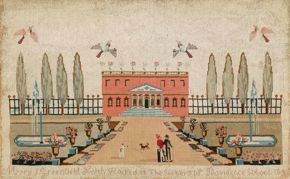Mary J. Greenfield Smith’s Window into American History March 22, 2017

Mary J. Greenfield Smith, Woolwork Picture, c. 1843, wool and silk on linen, the Museum of Fine Arts, Houston, the Bayou Bend Collection, Museum purchase funded by Miss Ima Hogg, by exchange, and Bobbie Nau.
In 1843, 14-year-old Mary J. Greenfield Smith stitched an elegant woolwork picture in school—surely not imagining that it would end up in a museum’s collection someday.
A Unique 19th-Century Story
Living in Baltimore with her parents, Maria and Peter Smith, young Mary attended a school for African American girls operated by the Oblate Sisters of Providence, the first Roman Catholic society for women of color in the United States. Sisters Elizabeth Clarisse Lang and Marie Balas founded the society in 1829 and opened the school with the support of Father James Joubert, a Sulpician priest.
There, Smith received an education normally reserved for white girls. She would have taken classes in religion, English, French, math, writing, sewing, washing, and ironing. The areas of sewing were not only those considered useful for ordinary household work, but also for making beautiful embroidery.
In 1847, the city directory listed Smith as a dressmaker, and by 1860, she had married Richard Hill. At the time of the American Civil War, Mary J. Hill was one of a small group of women who sewed the Fourth Regiment United States Colored Troops Flag, now in the Maryland Historical Society’s collection. A Bayou Bend docent recently discovered this fascinating connection between the two museum objects made by the same woman: one in 1843, and the other in 1863.
Taking a Close-up
Woolwork is similar to needlepoint, though the technique uses wool yarn rather than thread to create an image sewn into a canvas or cloth. Made with wool and silk threads stitched into linen, Smith’s woolwork picture of 1843 is rather large, measuring 15 1/2 by 25 inches. It depicts a two-story house at the end of a wide walkway, where a couple strolls side-by-side as a child and dog play together. Above, four birds soar upward, and along the bottom, she stitched, “Mary J. Greenfield Smith Work at the Sisters of Providence School 184–.” Unfortunately, the last digit is missing, but the date is believed to be 1843.
A Place in History
One of only a few surviving examples of African American woolwork from this era, this 1843 image serves as a window into a rarely seen segment of American history. It symbolizes the hard work of many young African American girls who struggled to find a place for themselves in the turbulent period of antebellum America in Baltimore, a city that straddled the divide between North and South.
Smith’s woolwork picture is on view at Bayou Bend through May 7.
In March, the Museum celebrates Women’s History Month by highlighting the immense contributions women have made to the arts. Learn more about the Museum’s #5WomenArtists campaign.





